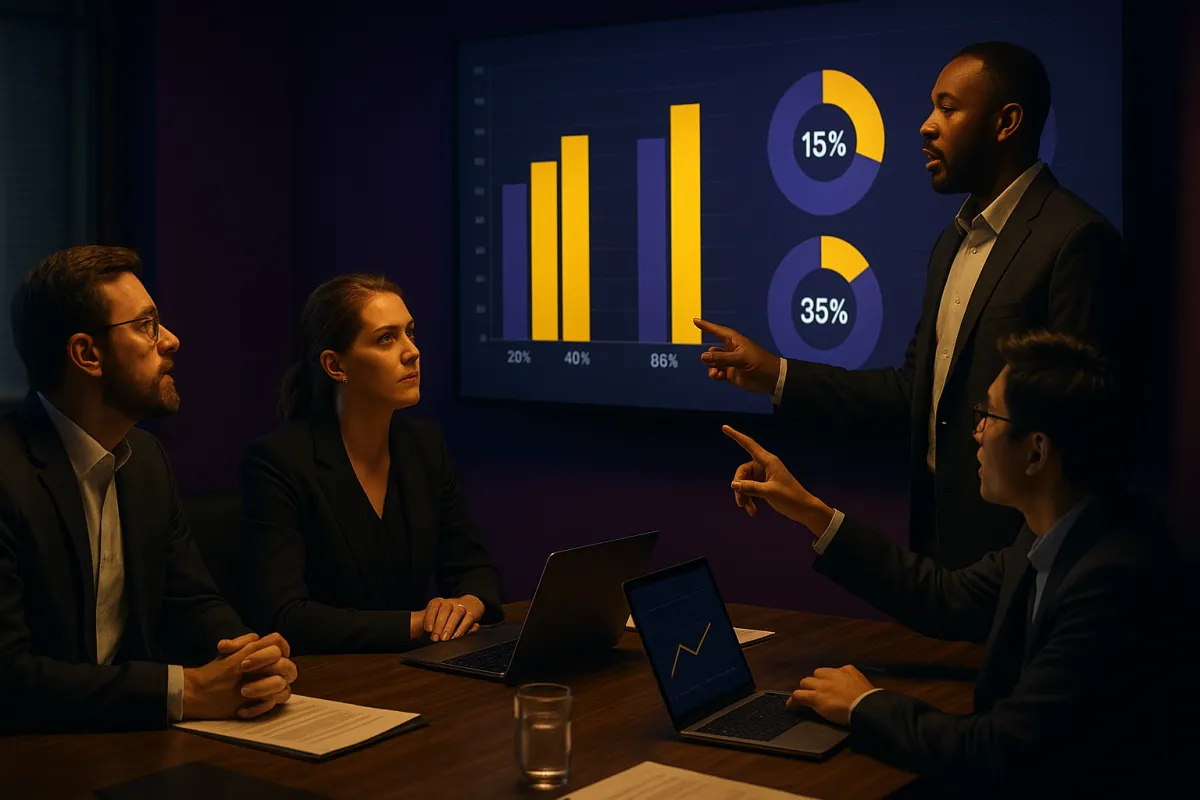By German Tirado, August 6, 2025

In the complex landscape of B2B marketing, where long procurement cycles, technical specifications and multi-stakeholder decisions reign supreme, many assume that the foundational laws of marketing science, Double Jeopardy and mental availability, no longer apply. Yet a wealth of large-scale, single-source studies from the Ehrenberg-Bass Institute demonstrates that B2B markets mirror consumer markets in predictable ways. Just as in B2C, brands with higher market penetration enjoy not only more customers but also stronger loyalty, while those with lower penetration suffer both fewer buyers and higher defection (Double Jeopardy law). Simultaneously, successful B2B brands build extensive memory structures, linking their names to diverse category entry points such as “contract renewal,” “compliance audits” or “IT infrastructure upgrades”, to ensure recall at the moment of need (mental availability).
Understanding these parallels is critical for B2B marketers seeking sustainable growth. Relying solely on targeted account-based tactics or niche differentiation neglects the power of broad-reach advertising, SEO-driven thought leadership and CEP-focused content that build brand salience across all buyer stages. By embracing marketing science principles, penetration as the primary growth lever, systematic mapping of category entry points, and budget allocation towards memory-building channels, B2B brands can achieve predictable gains in market share, retention and revenue. This article unpacks the empirical evidence behind Double Jeopardy and mental availability in B2B, dispels the myth that “B2B is different,” and outlines a roadmap for applying these universal growth laws to your enterprise marketing strategy.
Table of Contents
The Myth: “B2B Is Different—The Laws Don’t Apply”
Double Jeopardy in B2B: Evidence & Implications
Mental Availability in B2B: Category Entry Points Matter
Why the “B2B Is Different” Myth Persists
Actionable B2B Growth Strategies
Key Metrics to Track
Conclusion
Frequently Asked Questions
1. The Myth: “B2B Is Different—The Laws Don’t Apply”

B2B marketing often involves:
Long purchase cycles with multiple decision-makers
Formal procurement processes and contract renewals
Rational, informed evaluations rather than impulse buys
Niche product and service offerings
From these factors arises the belief that B2B buyers behave fundamentally differently, and that universal empirical laws like Double Jeopardy and mental availability have no place. Yet extensive single-source data across diverse B2B categories reveals otherwise.
2. Double Jeopardy in B2B: Evidence & Implications

Double Jeopardy Law: Brands with lower penetration suffer two penalties: they have fewer customers and those customers are less loyal [1].
2.1. Business Banking Case Study
A study of UK business bank accounts covering 5 million active accounts found:
Top-penetration banks (≥30 % share) saw average annual account retention of 85 %.
Lower-penetration banks (<5 % share) averaged 65 % retention.
Small banks not only had fewer customers but also experienced 1.3× higher churn [1].
2.2. Commercial Insurance Example
Analysis across 17 lines of commercial insurance in the US showed:
Brands with sub-1 % penetration lost 20 %+ of customers annually.
Brands above 10 % penetration lost fewer than 10 % [1].
Defection rates and penetration correlated at r=–0.72, matching B2C patterns.
2.3. Multi-Product Repertoire Effects
Whether it’s enterprise software suites or chemical suppliers:
Larger B2B brands tend to sell more product lines per customer.
Smaller brands not only have fewer customers but those customers buy fewer categories [1].
Implication
Focusing exclusively on deepening relationships with existing clients (loyalty programs, VIP tiers) neglects the primary driver of B2B growth: penetration [1].
3. Mental Availability in B2B: Category Entry Points Matter

B2B buyers encounter many triggers during their workflow. Common CEPs include:
When: “Renewing support contract”
Where: “At the procurement portal”
While: “Evaluating competitor bids”
With/Instead-of What: “Versus open-source alternatives”
With/For Whom: “For IT directors”
How Feeling: “Frustrated by downtime”
Why: “To ensure compliance” [3]
Larger brands link to more CEPs: a leading ERP vendor averaged 14 CEPs vs. 5 for a niche provider [3].
3.2. CEP Breadth & Loyalty
Regression across 17 insurance products found each additional CEP linked to a brand reduced yearly defection by ~5 % (p<0.05) [3]. The broader your memory links, the more likely buyers recall you under diverse circumstances.
3.3. The 95-5 Rule in B2B
Only ~5 % of B2B buyers are actively in-market at any given time. The other 95 % still see your ads, websites and content long before they purchase [4].
Brands that invest in broad-reach mental availability see 2× higher penetration growth over 3 years vs. those focusing solely on in-market channels [4].
Implication
Building a robust network of CEPs through varied touchpoints, whitepapers, webinars, trade shows, programmatic display, drives recall when buyers enter the market [4].
4. Why the “B2B Is Different” Myth Persists
Perceived Difference
Empirical Reality
Complex buying committees
Purchase frequency and defection still follow Double Jeopardy, regardless of number of approvers [1].
Rational evaluations
Memory links (mental availability) drive shortlist inclusion, even for “rational” B2B buyers [3].
Niche segments require targeting
Duplication of Purchase shows buyers overlap massively across brands; broad reach remains key [2].
Contractual inertia prevents churn
Even with contracts, defection correlates strongly with penetration, challenging “stickiness” myths [1].
5. Actionable B2B Growth Strategies

Benchmark Penetration vs. Defection.
Measure your brand’s penetration in each target segment quarterly.
Compare actual defection against Double Jeopardy expectations: smaller brands should expect higher churn unless they build greater mental availability [1].
Audit & Expand CEP Coverage.
Conduct buyer interviews to uncover top 10 CEPs per segment.
Map existing content/channels against these CEPs; prioritize gaps.
Aim to link your brand to 12+ CEPs within 12 months [3].
Allocate 70 %+ Budget to Broad-Reach Media.
Use programmatic display, LinkedIn brand campaigns, industry podcasts, trade publications.
Reserve 30 % or less for in-market SEM and retargeting [4].
Simplify Physical Availability.
Ensure your solutions appear on major tender lists and e-procurement portals.
Optimize website SEO for long-tail CEP keywords (e.g., “compliance software renewal” vs. generic “ERP”).
Monitor Mental Availability Metrics.
Track aided recall on key CEP prompts via bi-annual surveys.
Set targets: e.g., 40 % aided recall on top 5 CEPs within 18 months.
6. Key Metrics to Track
Metric
Why It Matters
Penetration Rate (%)
Primary growth lever; drives loyalty secondarily [1].
Defection Rate vs. Expected DJ
Diagnose under- or over-performance vs. Double Jeopardy benchmarks [1].
CEP Coverage (# of linked CEPs)
Proxy for mental availability breadth [3].
Aided Recall (%) by CEP
Direct measure of mental availability strength.
Reach & Frequency in Out-of-Market
Investment in memory building, forecast penetration gains [4].
7. Conclusion
B2B marketing need not reinvent the wheel, empirical marketing science from the Ehrenberg-Bass Institute demonstrates that Double Jeopardy and mental availability apply in B2B just as powerfully as in consumer markets. Brands with higher market penetration not only attract more corporate buyers but also enjoy stronger customer retention, while smaller B2B brands suffer both fewer clients and higher defection rates, exactly as the Double Jeopardy law predicts [1]. Likewise, building extensive memory structures, linking your brand to multiple Category Entry Points such as “contract renewal,” “compliance audit,” or “software integration”, drives brand salience and ensures recall at critical purchase moments [3].
Ignoring these universal laws in favor of purely niche or account-based marketing tactics risks leaving growth on the table. Instead, successful B2B brands blend broad-reach advertising, SEO-driven thought leadership, and content marketing targeted at diverse CEPs to boost mental availability among the 95% of out-of-market buyers [4]. They then reinforce this with simplified physical availability, ensuring visibility on e-procurement portals, tender lists and partner ecosystems.
By prioritizing penetration as the key growth lever, systematically mapping and expanding CEP coverage, and allocating at least 70% of budget to memory-building channels, B2B marketers can achieve measurable gains in market share, customer loyalty, and revenue growth. Abandon the “B2B is different” myth, anchor your enterprise marketing strategy in evidence-based B2B growth strategies, and unlock the predictable, sustainable growth patterns that marketing science has proven time and again.
Frequently Asked Questions (FAQs)
Q1: What is the Double Jeopardy law and how does it apply to B2B marketing?
The Double Jeopardy law states that brands with lower market penetration not only have fewer customers but also suffer higher defection rates. In B2B markets, spanning banking, insurance and enterprise software, brands with sub-5% penetration lose up to 20% of clients annually, whereas those above 10 % penetration see under 10% churn [1].
Q2: Why is market penetration more critical than loyalty for B2B growth?
Empirical evidence shows that increasing penetration drives both customer acquisition and retention. Loyalty programs or account-based tactics alone cannot overcome the loyalty shortfall predicted by Double Jeopardy, genuine growth requires winning more buyers first [1].
Q3: What are Category Entry Points (CEPs) in B2B, and why do they matter?
CEPs are the situational cues that trigger brands in buyers’ memories (e.g., “contract renewal,” “compliance audit”). Leading B2B brands link to 12–14 CEPs on average, versus 4–6 for smaller providers—boosting recall and reducing defection by ~5% per additional CEP [3].
Q4: How many CEPs should a B2B brand aim to cover?
To maximize mental availability, target at least 12 distinct CEPs within 12 months. This breadth ensures your brand is top-of-mind across varied purchase situations, from technical evaluations to budget approvals [3].
Q5: What is the 95-5 rule in B2B marketing?
Only about 5 % of B2B buyers are actively in-market at any time; 95% are out-of-market. Brands that invest in broad-reach advertising, webinars, whitepapers, programmatic display, achieve double the penetration growth over three years compared to those focusing solely on in-market SEM and retargeting [4].
Q6: How should B2B marketers allocate their budgets between memory-building and in-market tactics?
Following the 95-5 rule, allocate 70–80% of your marketing budget to memory-building channels (broad-reach SEO, thought leadership, industry media) and 20–30% to in-market tactics (SEM, retargeting, account-based campaigns) to drive sustainable penetration and long-term growth [4].
Q7: What role does physical availability play alongside mental availability?
Physical availability, being easy to buy via e-procurement portals, tender lists and partner networks, reinforces mental availability. Simplify procurement pathways and optimize CEP-driven SEO keywords (e.g., “compliance software renewal”) to ensure buyers can act when recall triggers them [3].
Works cited
[1] The Double Jeopardy Law in B2B shows the way to grow. Jenni Romaniuk, John Dawes & Sahar Faghidno. Ehrenberg-Bass Institute, May 2021.
[2] How do Business-to-Business (B2B) brands compete? Jenni Romaniuk. Ehrenberg-Bass Institute, May 2021.
[3] Category Entry Points in a Business-to-Business (B2B) world. Jenni Romaniuk. Ehrenberg-Bass Institute, July 2022.
[4] Advertising effectiveness and the 95-5 rule: most B2B buyers are not in the market right now. John Dawes. Ehrenberg-Bass Institute, May 2021.
Address
Phone: 725-240-6870
Email : [email protected]
Address : 6440 Sky Pointe Dr. #140-341 Las Vegas, NV 89131
Artificial Intelligence
Marketing & Branding
Marketing & Branding
©2025 Max Digital Edge | All Rights Reserved
